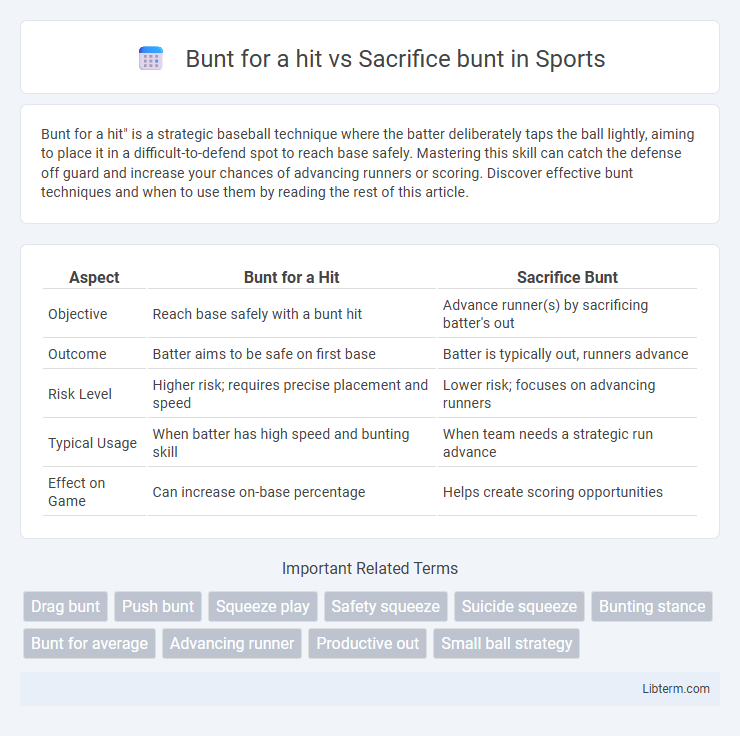Bunt for a hit" is a strategic baseball technique where the batter deliberately taps the ball lightly, aiming to place it in a difficult-to-defend spot to reach base safely. Mastering this skill can catch the defense off guard and increase your chances of advancing runners or scoring. Discover effective bunt techniques and when to use them by reading the rest of this article.
Table of Comparison
| Aspect | Bunt for a Hit | Sacrifice Bunt |
|---|---|---|
| Objective | Reach base safely with a bunt hit | Advance runner(s) by sacrificing batter's out |
| Outcome | Batter aims to be safe on first base | Batter is typically out, runners advance |
| Risk Level | Higher risk; requires precise placement and speed | Lower risk; focuses on advancing runners |
| Typical Usage | When batter has high speed and bunting skill | When team needs a strategic run advance |
| Effect on Game | Can increase on-base percentage | Helps create scoring opportunities |
Introduction: Understanding Baseball Bunts
A bunt for a hit involves the batter intentionally tapping the ball lightly into play to reach first base safely, exploiting speed and infield positioning. In contrast, a sacrifice bunt is primarily designed to advance a baserunner, where the batter usually expects to be thrown out after successfully placing the ball in a strategic spot. Understanding these bunt types is crucial for mastering situational baseball strategies and improving offensive efficiency.
Definition: What is a Bunt for a Hit?
A bunt for a hit is a strategic baseball play where the batter intentionally taps the ball lightly in the infield with the goal of reaching base safely, typically by exploiting defensive positioning or surprise. Unlike a sacrifice bunt, which aims to advance a runner at the cost of an out, a bunt for a hit is an attempt to record a base hit without sacrificing the batter's chance of remaining on base. This tactic relies on precise placement and speed, making it a valuable offensive tool in close games or hit-and-run scenarios.
Definition: What is a Sacrifice Bunt?
A sacrifice bunt is a strategic baseball play where the batter deliberately bunts the ball to advance a baserunner, sacrificing their chance to reach base safely. Unlike a hit bunt, where the batter aims to reach base with a well-placed bunt, the sacrifice bunt prioritizes moving runners into scoring position. This tactic often occurs with no outs or one out to increase the team's scoring opportunities.
Core Differences Between Bunt for a Hit and Sacrifice Bunt
Bunt for a hit aims to place the ball in play with the intention of reaching base safely, prioritizing speed and placement over advancing other runners. Sacrifice bunt focuses on advancing runners by deliberately making an out, trading the batter's opportunity to reach base for team advancement. The core difference lies in the batter's objective: reaching base safely versus strategically advancing runners at the cost of the batter's own out.
Strategic Purposes of Bunt for a Hit
A bunt for a hit is strategically employed to surprise the defense and exploit gaps in the infield, aiming to safely reach base by outrunning fielders. This technique emphasizes speed and placement, often targeting areas difficult for defenders to cover quickly. Unlike a sacrifice bunt, which prioritizes advancing runners at the cost of the batter's out, a bunt for a hit prioritizes the batter's safe arrival on base while maintaining offensive momentum.
Strategic Purposes of Sacrifice Bunt
The strategic purpose of a sacrifice bunt is to advance a baserunner into scoring position while willingly giving up the batter's opportunity to reach base safely. Unlike a bunt for a hit, which aims to exploit defensive gaps for the batter to reach first, a sacrifice bunt prioritizes team advancement over individual statistics. This tactic is especially effective in close games where scoring a single run can significantly impact the outcome.
Situational Use: When to Choose Each Type
A bunt for a hit is ideal in situations where the batter relies on speed to reach base safely, such as with runners on first base and no outs, aiming to exploit defensive positioning or infield shifts. A sacrifice bunt suits scenarios where advancing runners into scoring position outweighs the importance of the batter's on-base percentage, typically with fewer than two outs and runners on base. Managers often select a bunt for a hit when the defense plays deep, while a sacrifice bunt is chosen to execute small-ball tactics, emphasizing run manufacturing in close games.
Key Player Skills for Effective Bunting
Effective bunting requires precise hand-eye coordination and strong bat control to place the ball accurately. Key player skills for a bunt for a hit include quick reflexes and speed to reach first base safely. In contrast, a sacrifice bunt demands discipline to prioritize advancing runners over personal base hits, emphasizing strategic placement and timing.
Statistical Impact: Bunt for a Hit vs Sacrifice Bunt
A bunt for a hit statistically increases a player's on-base percentage by converting weak hits into infield singles, often resulting in a higher batting average on balls in play (BABIP) compared to traditional swings. Sacrifice bunts, while lowering the individual's slugging percentage and on-base percentage, significantly enhance team run expectancy by advancing runners into scoring position, thereby positively impacting expected runs scored in an inning. Statistical analyses reveal that bunt-for-hit attempts tend to be more favorable for players with high speed and contact rates, whereas sacrifice bunts provide situational value despite reducing personal offensive metrics.
Conclusion: Maximizing Offensive Strategy with Bunts
Maximizing offensive strategy with bunts involves using a bunt for a hit to surprise the defense and create infield hits, increasing the chance of reaching base safely. In contrast, a sacrifice bunt prioritizes advancing base runners at the cost of an out, strategically improving scoring opportunities. Both tactics require situational awareness and precise execution to optimize team scoring potential.
Bunt for a hit Infographic

 libterm.com
libterm.com